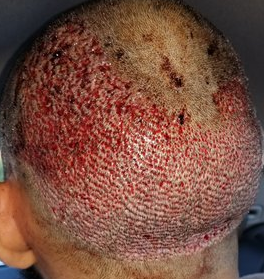I’m thinking about getting a strip method hair transplant and then just filling in the scar with FUE. Is that an option thats worth pursuing? I don’t want the line scar but I want every graft transplanted. I understand FUE has problems with transection or something.
I get this question quite a bit from patients who have already had the hair transplant strip surgery and then inquire about having a follicular unit extraction (FUE) procedure to follow it up. It makes little sense for the person that already has a strip scar (no matter how wide it is) to have an FUE into the donor harvest. If it’s just about treating the linear scar, better solutions would be a scar revision or Scalp MicroPigmentation (SMP). FUE grafts used in linear scars are generally wasteful and an expensive way to treat the scar with less than ideal results.
My complaints about the way the FUE technique is used are:
- It’s generally more expensive than a scar revision for those with a troublesome linear scar.
- The grafts do not come out of the sweet spot in the middle of the donor area (where the grafts are easily taken by a strip).
- In my opinion, the overall survival of the FUE grafts are not as good as those harvested from a strip in most doctor’s hands (I do not believe that is a problem in our hands).
As the first to publish a paper on FUE (introducing it to the medical community), I can speak with authority on these issues. The ARTAS FUE robot has not really changed the process, except for leveling the playing field for those doctors not skilled in the extraction technique. The FUE technique, as done in most doctor’s hands without the robot, is not as good as the grafts produced by a strip surgery. If there was a formal study, I would expect that each doctor would show variable comparative results when comparing their FUE results with this strip results, making such a comparison between FUE and strip surgery essentially worthless.
The presence of a fine line scar will not be seen in most patients who had a strip procedure, because they generally leave their hair just long enough to cover a strip scar. If they were to cut the donor area hair very close to the scar, at some point (depending upon hair length) the scar will show. I had two hair transplants and although I have a scar, few people can see it even when I show it to patients who visit me in the office. The public does not understand that there is scarring in FUE procedures, even though some doctors and clinics promote it as “scar-less” surgery. In some patients we have had to treat these FUE scars with SMP to allow for a close haircut or shave. The SMP process is the only one that treats FUE scars today and we are seeing more and more patients with this problem as time goes on. I suspect that the strip scar issue is more of a problem with a person who has dark hair and white skin, than the person who has medium brown hair and an olive skin. Nevertheless, both techniques do have consequences.
Here is an example of scarring from a large FUE procedure with the hair cut short. While there is no linear scar, you can clearly see the white pinpoint dot scars all over the back of the scalp. We’ve treated this with SMP (photos to come in a follow-up post later). Click the photo to enlarge.
With all that being said, I am not denigrating FUE. It is an important technique and in certain situations it may be superior to a strip surgery. Examples of superior candidates include those without large balding areas, and athletes who want to be able to resume full exercises and swimming within a week of the surgery; however, in patients with large balding patterns, taking the required number of grafts through FUE is not efficient and is relatively more expensive. There is massive experience with strip harvesting (some good and some bad). I have seen in some patients that visit me, that many doctors are harvesting grafts with FUE from the non-permanent areas to reflect a large need for grafts in a single session. Grafts that are taken from the non-permanent zone, may not last.

